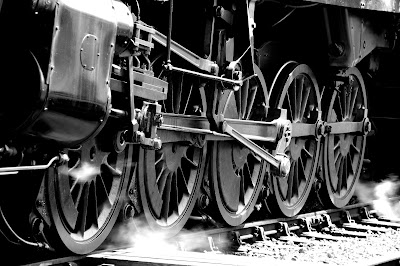The British Railways standard class engines, designed and built in the 1950s, were hybrids - seeking to combine the best engineering traditions from each of the railways which had been nationalised by the postwar Labour government. Without shareholders to please, or investors to impress, and without the need to lure passengers from rival networks with glamorous advertising; the "standards" eschewed style in favour of rugged functionality and efficiency. This was never more the case than in the freight powerhouse the "9F", which although sometimes drafted in to run passenger trains like the famous "Pines Express" over the Somerset & Dorset; was primarily designed for carrying great loads of heavy goods. The massive boiler and great outside cylinders bore their weight down upon ten connected driving wheels to deliver the massive tractive effort the 9F produced. The result was a great locomotive.
A delay in departure at Sheffield Park, means a waste of carefully prepared steam. The valves lift and a great roar of steam expands into the afternoon Sussex air.
The fireman works the shovel, building up a good head of steam for the afternoon train North to East Grinstead. With every shovel load, the smoke darkens.
After a delayed start, the 9F eases its coaches northwards from Sheffield Park, with spare steam still billowing from the valves. A five-coach train is effortless for an engines capable of hauling 1000+ ton coal trains. With little more than a few barks from the chimney, the train reaches, 25mph, the speed limit on this line.
Entering the new Bluebell Railway station in East Grinstead, coming off the viaduct which takes the trains high over the town, the 9F shimmers in bright afternoon sun, waiting permission to draw alongside the platform.
At rest, Sheffield Park.











1 comment:
love the first and second pics. we don't have this anymore in Indonesia, so it is sad to see that my nephew doesn't have this fascination I experienced as a kid.. for them, train is that Thomas & Friends! :((
Post a Comment